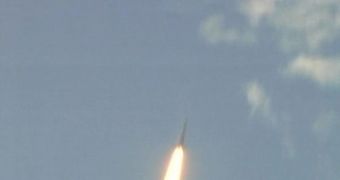Officials at the European Space Agency (ESA) are proud to announce the successful launch of a new Ariane 5 heavy-lift delivery system, which managed to deliver two brand new telecommunications satellites to our planet's orbit. The take off took place yesterday evening, August 5, from the Kourou Spaceport. This is an ESA facility in the French Guiana, South America, that handles all of the agency's satellite and spacecraft launches. Currently, the spaceport is being modified to allow for Russian-built Soyuz rockets to be launched from that location.
The Ariane 5 rocket, the workhorse at ESA, placed its cargo in geostationary transfer orbits. The two satellites, called Nilesat-201 and Rascom-QAF1R, were carried to orbit as part of the 52nd mission flown by the renowned rocket (flight V196). The flight began at precisely 22:59 CEST (20:59 GMT; 17:59 French Guiana), when the liquid-propellant-fueled main engine ignited. The two spacecrafts were inserted into their orbits very accurately, at T+28 minutes and T+32 minutes after liftoff, respectively. The target injection orbit had an inclination of 2º, and a perigee altitude of 250 kilometers. The apogee altitude at injection was 35,919 kilometers.
“Nilesat-201 will be positioned in geostationary orbit at an altitude of about 35,800 km over the equator at 7°W and will provide broadband direct-to-home television broadcast services to North Africa and the Middle East in the Ku- and Ka-bands. Rascom-QAF1R, to be positioned at 2.85°E, will provide communications services in rural parts of Africa, including long-distance domestic and international links, direct TV broadcasts and Internet access. The payload mass for this launch was 7085 kg; the satellite masses totaled 6250 kg, with payload adapters and dispensers making up the additional 835 kg,” ESA officials say of the cargo on the latest Ariane 5 space flight.
ESA plans to launch an additional three space flights using Ariane rockets, in collaboration with Arianespace, the main contractor building the space vehicle. This very large launch rate is possible due to the fact that the agency imposed a very alert pace in the launch/reset/launch cycle that governs every spaceport. For example, between August 2007 and August 2008, nine rockets took off from Kourou, which is the equivalent of one every 40-42 days. For comparison, NASA keeps at least two to three months of free time between shuttle launches.

 14 DAY TRIAL //
14 DAY TRIAL //